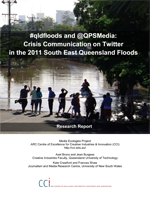Brisbane.
The next speaker at ANZDMC is Paul Pisasale, the Mayor of Ipswich (which was also severely affected in the 2011 south-east Queensland floods, of course). Paul is currently in re-election mode, so he starts with a bit of a sales pitch for Ipswich.
He notes the problems of talking to the media during the crisis: while the disaster management team might have known what a prospective flood level of 18m meant, the media largely didn’t, and this had the potential of causing substantial stress for the community – so there needed to be clear communication strategies for getting the …

 Twelve months ago Brisbane, and the South East Queensland region, were just about to begin the long process of recovery from the major floods which affected Toowoomba, the Lockyer Valley, Ipswich, and Brisbane itself. One of the more positive stories to emerge from the crisis, though, was how social media were used as a tool for sharing news and information about the disaster, and for assisting locals with organising the (significantly volunteer-driven) relief and recovery effort.
Twelve months ago Brisbane, and the South East Queensland region, were just about to begin the long process of recovery from the major floods which affected Toowoomba, the Lockyer Valley, Ipswich, and Brisbane itself. One of the more positive stories to emerge from the crisis, though, was how social media were used as a tool for sharing news and information about the disaster, and for assisting locals with organising the (significantly volunteer-driven) relief and recovery effort.











